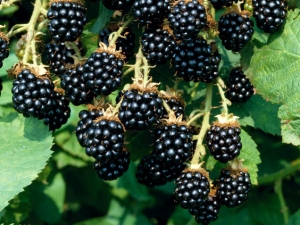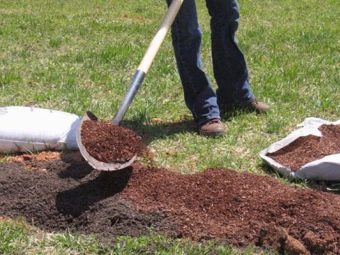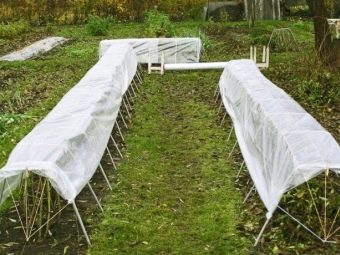Blackberry "Loch Tey": description, fit and care

Lough Tay is a thornless blackberry that has won recognition in Europe and, more recently, has been popular in Russia. It can be grown both at home and on an industrial scale.This variety appeared in Scotland and was bred from a hybrid "Lochness", it is notable for its amazing taste qualities and is resistant to various climatic conditions.
Features grade
This variety appeared in Russia in 2011. The description should start with the fact that it is ultra early, the first harvest appears in July, however, in the southern latitudes, the berries can be ripened by mid-June. Accordingly, when it comes to the northern regions, the blackberry gives fruit later. This is a semi-detachable shrub of impressive size, the length of the branches can reach 4.5 meters. The stems themselves are soft brown in color and do not have thorns. After the middle of the bush branches begin to bend. The leaves have a dense skin, emerald green color and teeth at the edges. During flowering shrub cover white flowers in inflorescences, small in size. To grow such a blackberry can be both in large areas and in limited on the garden areas.
Summer residents note the high yield of Lok Tey, because one bush can bring up to 20 kilograms of delicious and fragrant berries. Most of the fruit appears on the 4-5 year after the plant is planted on the site. The fruits themselves are dark and slightly elongated in shape. One berry has a weight of about 10 grams. The taste of blackberry is very sweet, after it finally ripens, the plant is distinguished by its silky skin and dense flesh.
To determine the ripeness of the fruit, you need to pay attention not to the saturation of color, and dried slightly on the sepals.
Advantages and disadvantages
Reviews gardeners say a significant number of advantages that distinguish this variety. First of all, it is the earlier ripening of berries and excellent yield. The fact that the shrub is spikeless becomes an indisputable advantage when harvesting, greatly simplifying and facilitating it. “Lough Tey” is a frost-resistant variety that can adapt to adverse climatic conditions, while tolerating drought and hot weather.
There is no doubt that the benefits of this culture for humans, because blackberries are very rich in vitamins. The variety is one of the sweetest. It is immune to many diseases and is resistant to pest attacks. In addition, Lough Tey perfectly transports transportation even over considerable distances and is able to be stored for quite a long time, while maintaining an attractive appearance and taste.
Among the shortcomings can be noted the relative demands in the care. If you do not carry out pruning, the variety is able to quickly spread throughout the territory. The fruiting period is short, the last harvest is collected at the end of July. Shrubs can also be affected by rust.
To this attack did not bring unnecessary problems, it is necessary to carry out preventive treatment, for which compounds containing copper are used.
How and where to land?
During the preparatory work it is important to choose the place where the blackberry will grow. Areas that have sufficient light and good ventilation are best suited. The soil should have a medium or slightly elevated level of acidity. The next stage is the right choice of saplings. In order for the plant to enjoy the fruits already in the first year after planting, it is worthwhile to dwell on saplings with a stem length of up to 40 centimeters. The plant should not have visual damage, it should also be examined for the presence of fungus. An important condition is sufficient development of the central root.
To plant the Lough Tey blackberry should be in the spring. The process is no different from planting other varieties. To begin with, the fossa is prepared, its size should be approximately 40 to 40 centimeters. Wood ash and humus are poured into the hole at a ratio of half a glass to half a bucket, and then poured with water. A sapling is placed on top, its roots are gently stretched, covered with earth, after which it is necessary to water the plant properly.After that, the shoot is cut, its height should not be more than 25 centimeters. Next, the soil is mulched, for which organic fertilizers are used.
In order for the bushes to properly develop and feel comfortable, the distance between them should be about 2 meters. If blackberries are grown on an industrial scale, one and a half meters is enough. The optimal width between the rows is about 3 meters. When a seedling begins to actively grow and develop, it is necessary to fix it on a support. To do this, you can take the usual wire and fix on the posts of wood or metal.
It should be borne in mind that only last year’s branches are tied up, while the young ones must be kept in a horizontal position, not higher than 20-30 centimeters from the ground. This is necessary so that the shoots are separated, which will be very convenient during the fruit harvesting period. In addition, in this position it is easier to cover the branches for the winter.
How to care?
Everyone knows that the better to care for the plant, the more abundant harvest it will please in the future. We will understand what kind of agrotechnical measures are necessary for the Lough Tey blackberry.
Watering
Despite the fact that this shrub can tolerate drought well, this item should not be ignored. Abundant and frequent watering is not required. Periodic soil moistening is necessary in the first year after planting, as well as during drought. However, watering more often than once every 2-3 weeks may harm the plant. Drip irrigation is the best option. Stems should be raised and fixed. Water should be warm and settled.
The last watering of the season must be made no less than 2 weeks before the shrub will take shelter for the winter period.
Pruning
This procedure must be carried out every year. When the shoot is in the process of growth, you need to get rid of the apical bud. The process is repeated twice, for the first time at a height of 35 centimeters, the second - slightly less than a meter. In the autumn should be sanitary pruning blackberries. In the course of it the branches are removed, which have dried up and will no longer give fruit. You also need to monitor the density of the plant. In the summer, pruning is also possible, but only for the purpose of removing damaged and weakened branches. It must be borne in mind that for an adult blackberry bush enough within 15 shoots of different ages.
Top dressing
This procedure is carried out from the second year of the plant life. In the spring, it is advisable to fertilize the soil fertilizer containing nitrogen, as well as organic matter and minerals. As for organic fertilizers, chicken manure and mullein are excellent. From minerals you can use urea. When flowering began and the first fruits appeared, the development of blackberry will well support fluorine and potassium, in this case it is better to use mineral complexes that have them in composition. Nitrogen fertilizing should be excluded until next spring, otherwise the plant will not survive the effects of low temperatures.
If you mulch the land, it will not allow the shrub to spread throughout the territory. Fertilizer layer should be from 5 to 10 centimeters.
Diseases and pests
This variety is notable for immunity to diseases and pests, however, there are exceptions. Danger to blackberries such diseases as gray mold and anthracnose. Sick bushes to be destroyed. To prevent the development of the disease, nearby plants are treated for prophylaxis. In case of gray rot, the shrub of potash nitrate should be sprayed, and the mulch from peat-based compost saves it from anthracnose.
Wintering
Before the beginning of winter, the stems should be laid on the ground. After that, they are filled with organic matter, you can use peat or foliage. A covering material is put on top. The lack of these actions can lead to the fact that the Lough Tey blackberry will simply freeze at extremely low temperatures.
In the next video you will find a review of the Loch Tay variety blackberry (Loch Tay).





























